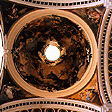
The Regina Martyrum cupola
of the Basilica del Pilar
(1780-1781) (Zaragoza)







 |
In October 1780 Goya, accompanied by his brothers-in-law Francisco and Ramón Bayeu, arrived in Zaragoza to paint again in the Basilica del Pilar. Francisco Bayeu, who had been commissioned by the Chapter to paint the vaults and cupolas surrounding the Holy Chapel, proposed that Goya should paint two of the cupolas and that he would paint the other two himself.
However Goya only painted the cupola adjoining the chapel of San Joaquín, with the title Regina Martyrum or Mary, Queen of Martyrs, because of the confrontations between him and Francisco Bayeu on the one hand, and the Junta de Fábrica, the directors of work on the cathedral on the other. The cause was Goya's rapid manner of painting, with large brushstrokes and staining and with little precision in the drawing, which gave the figures an unfinished appearance. This caused severe criticism on the part of the Junta de Fábrica and others, which finally reached Francisco Bayeu. Goya's free and rapid approach clashed with the Classicist tastes of the period, which were precisely the opposite. Clearly defined figures were preferred, with well marked lines and contained, elegant postures. The whole affair caused arguments and confrontations for the painter. The Prior of the Carthusian monastery of Aula Dei was forced to mediate a solution agreeable to both the painter and the Junta. Regina Marytrum is a marvellous composition and is beautifully coloured. It is, without doubt, one of the truly great works of Goya's career. It summarizes Goya's training in the rich tradition of late Baroque and Rococco painting, but he transforms it by renewing the language of decoration, thus incorporating a naturalism that can be seen for example in the figures of the martyrs. Without renouncing the essentially supernatural sensation of the work, the saints are imbued with a flesh and blood quality which makes them real men and women. Some of them look like typical Aragoneses dressed in clothing of the period. Below the shining figure of the Virgin Mary are placed the perfectly characterized figures of the saints. St. Laurence with a spiritual gaze, St. Engracia, with the hammer and nails of her martyrdom, St. Lambert the beheaded saint, with his head held in his hands and the holy children Justo and Pastor next to St. Catalina. In another part of the cupola appear, amongst others, St. Sebastian and St. Barbara; St. George carrying the flag of the red cross of Aragon which is named after him; St. Esteban and the infant child St. Domingo de Val, whose head is a magisterial lesson in true realism. On the pendentives are represented Charity, Faith, Fortitude and Patience, inspired by the iconology of Cesare Ripa. See also:
Arturo Ansón |
|
| Regina Martyrum |  |
|
| Faith |  |
|
| Pacience |  |
|
| Fortitude |  |
|
| Charity |  |
|
| Adoration of the Name of God in the Coreto of El Pilar |
 |
InfoGoya 96 is an initiative of the University of Zaragoza, sponsored by the Institution Fernando el Católico of the Deputation of Zaragoza on an Apple Internet Server donated by Apple Computer. |    |